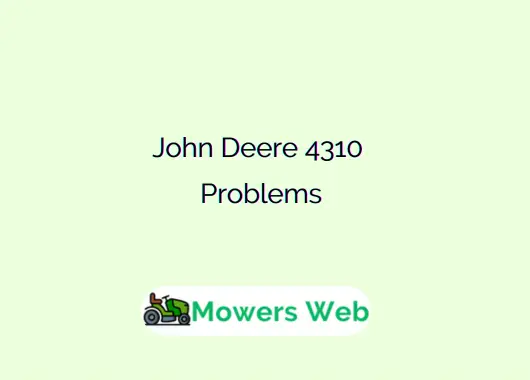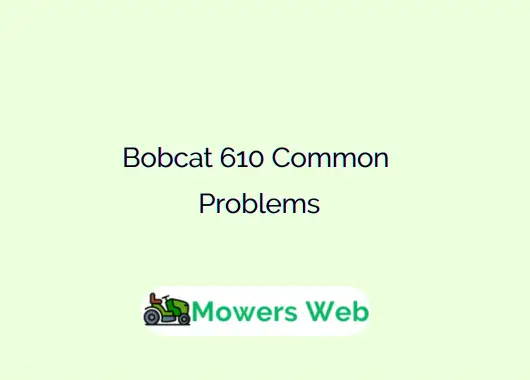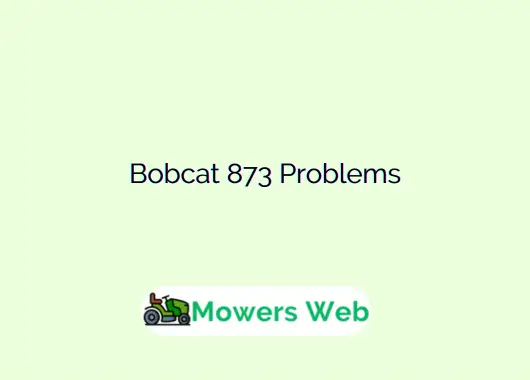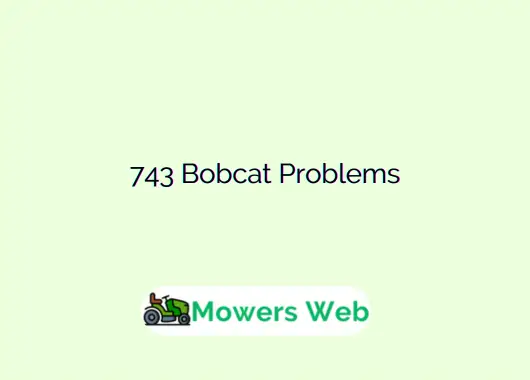The John Deere 4310 is a compact utility tractor well-regarded for its reliability, efficiency, and versatility in agricultural, landscaping, and small-scale farming applications.
John Deere 4310 Problems
1. Hydraulic System Problems
One of the most reported John Deere 4310 problems involves the hydraulic system. Many users experience weak hydraulics, slow response times, or complete failure of the system.
Common symptoms include:
- Loader arms not lifting properly
- Slow or jerky hydraulic movements
- Hydraulic oil leaks near the pump or hoses
Causes:
- Low hydraulic fluid levels or contaminated fluid
- Clogged hydraulic filters
- Worn-out hydraulic pump or seals
Solutions:
- Check the hydraulic fluid level and top it up using the recommended John Deere Hy-Gard fluid.
- Replace the hydraulic filter if it’s clogged.
- Inspect hoses, seals, and fittings for leaks and replace worn components.
- If the pump is defective, rebuilding or replacing it is the best long-term fix.
Keeping the hydraulic system clean and well-maintained is crucial for maintaining the performance and lifting power of your 4310.
Related John Deere 6420 Problems(8 Causes + Solutions)
2. Transmission Issues
The John Deere 4310 comes with either a hydrostatic transmission (HST) or a PowerReverser transmission, both of which are generally reliable. However, users sometimes experience issues such as slipping, jerky movement, or difficulty engaging gears.
Common symptoms include:
- Tractor not moving when in gear
- Delayed response when shifting directions
- Strange whining noise from the transmission area
Possible causes:
- Low or contaminated transmission oil
- Air trapped in the hydrostatic system
- Faulty transmission linkage or worn clutch components
Solutions:
- Ensure the transmission oil is at the correct level and replace it at recommended intervals.
- Bleed air from the system after changing hydraulic or transmission fluids.
- Adjust or replace the linkage if it’s out of alignment.
- For PowerReverser units, check clutch packs and solenoids for wear or electrical faults.
Regular transmission maintenance and using the right type of oil can prevent most of these issues.
Related John Deere Power Reverser Transmission Problems(Fixed)
3. Electrical and Starting Problems
Another area where John Deere 4310 problems frequently appear is in the electrical system. Many owners report difficulty starting the tractor, flickering dashboard lights, or intermittent power loss.
Common symptoms:
- Engine cranks but won’t start
- Clicking sound when turning the key
- Battery drains quickly or fails to hold a charge
Causes:
- Weak or dead battery
- Corroded battery terminals or loose wiring connections
- Faulty safety switches (seat, PTO, or neutral switch)
- Bad starter solenoid or ignition switch
Solutions:
- Check the battery voltage (should be around 12.6V fully charged) and replace it if it is weak.
- Clean terminals and tighten connections.
- Test safety switches using a multimeter and replace any faulty ones.
- Inspect the starter motor and solenoid for proper function.
Electrical problems often seem complex, but most can be fixed with proper inspection and maintenance of the wiring and battery system.
4. Engine Performance Issues
Some operators have reported engine-related problems, such as poor performance, hard starting, or black smoke from the exhaust. These issues can be frustrating, especially when the tractor struggles during heavy workloads.
Common causes include:
- Clogged fuel filters or dirty injectors
- Air filter blockage restricting airflow
- Old or contaminated fuel
- Faulty glow plugs (especially in cold weather)
Solutions:
- Replace the fuel and air filters regularly.
- Clean or replace fuel injectors if they’re dirty.
- Use clean, high-quality diesel fuel to avoid contamination.
- Check and replace glow plugs to ensure easy cold starts.
Regular engine tune-ups, proper fuel management, and periodic maintenance can significantly improve engine performance and longevity.
Related 10 Common John Deere 185 Hydro Problems(With Solutions)
5. PTO (Power Take-Off) Problems
The PTO system in the John Deere 4310 is responsible for powering attachments like mowers and tillers. Some users face issues where the PTO won’t engage or disengage properly.
Common symptoms:
- PTO won’t start when the switch is engaged
- PTO runs continuously even when turned off
- Strange noises from the PTO clutch area
Causes:
- Faulty PTO switch or solenoid
- Worn PTO clutch or linkage issues
- Electrical problems in the PTO circuit
Solutions:
- Test the PTO switch and solenoid for proper operation.
- Inspect clutch components for wear and replace if needed.
- Ensure the PTO linkage is correctly adjusted.
A properly functioning PTO system ensures that attachments run efficiently, making maintenance essential for optimal tractor performance.
6. Steering and Front Axle Problems
Some John Deere 4310 owners also report steering difficulties or front axle problems, especially in four-wheel-drive models.
Typical symptoms:
- Stiff or unresponsive steering
- Uneven front tire wear
- Grinding noise when turning
Possible causes:
- Low power steering fluid
- Damaged tie rods or steering cylinder
- Worn bearings in the front axle assembly
Solutions:
- Check and refill the power steering fluid reservoir.
- Replace damaged tie rods or cylinders.
- Inspect the front axle and replace worn bearings or seals.
Regular lubrication and inspection of the steering and axle components can help prevent these issues from worsening.
Related Why Lawn Mower Backfires(5 Reasons + Solutions)
7. Overheating Issues
Although less common, overheating can occur if the radiator is clogged or the cooling system isn’t working efficiently.
Causes:
- Dirty radiator fins or low coolant levels
- Faulty thermostat or water pump
- Broken fan belt
Solutions:
- Clean the radiator regularly to prevent debris buildup.
- Check coolant levels and refill as needed.
- Replace any defective thermostat, pump, or belt.
Keeping the cooling system in top condition prevents engine damage and ensures reliable tractor performance.
Related Is the Lawn Mower 2.0 Waterproof(Explained in Details)
FAQs
What year did John Deere make the 4310?
The John Deere 4310 was manufactured between 2002 and 2004 as part of the 4000 Ten Series compact utility tractors. Despite its short production run, it gained popularity for its versatility and reliability, making it a favorite among small farm owners and landscapers.
What are John Deere’s weaknesses?
While John Deere tractors are known for their quality and durability, some common weaknesses include:
- High repair and maintenance costs compared to other brands
- Expensive parts and accessories
- Complex electronics that can be difficult for DIY repair
- Hydraulic and electrical issues in older models
- Limited dealer coverage in certain rural areas
Overall, John Deere’s strengths far outweigh its weaknesses, but maintenance and parts costs are the main drawbacks.
What is a John Deere 4310 worth?
The value of a John Deere 4310 depends on factors such as age, condition, and included attachments. On average, as of 2025:
- Used models typically range between $10,000 and $18,000
- Well-maintained units with loaders or backhoes can fetch up to $20,000 or more
Checking local listings and online marketplaces can give a better estimate based on current demand.
How many horsepower does a John Deere 4310 have?
The John Deere 4310 is powered by a 32.4-horsepower Yanmar 3-cylinder diesel engine. Its power take-off (PTO) horsepower is around 27.5 HP, depending on the transmission type. This makes it capable of handling light to medium-duty farming and landscaping tasks efficiently.
What is the lift capacity of a John Deere 4310 loader?
When equipped with the John Deere 430 front-end loader, the 4310 has a lift capacity of approximately 1,259 pounds (571 kg) at full height. This allows it to handle most small-scale lifting jobs, such as moving soil, mulch, gravel, or pallets, with ease and stability.
Final Thoughts
While the John Deere 4310 problems mentioned above can be frustrating, most of them are relatively easy to fix with timely maintenance and proper troubleshooting. Regular inspections, fluid changes, and using genuine John Deere parts will go a long way in extending the tractor’s lifespan.
With good care, the 4310 remains one of the most dependable compact utility tractors for small farms and property maintenance, a true testament to John Deere’s legacy of quality engineering.




